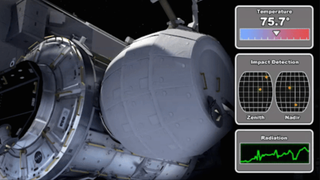Why this inflatable habitat is headed to the space station
Courtesy of SpaceX's Dragon

An inflatable space habitat that could one day ferry people to Mars and on other deep space missions is headed up to the International Space Station (ISS) this Friday.
The habitat, known as the Bigelow Expandable Activity Module (BEAM), was developed by space tech company Bigelow Aerospace using a patent from NASA. It's essentially an expandable room made up of layers of fabric.
Designed to be easily transportable and simple to set up, NASA plans on attaching the BEAM to a berthing port on the ISS where it will be docked for two years.
In that time, Bigelow hopes to demonstrate the BEAM's capabilities, which include folding and packing techniques, radiation protection, and thermal, structural and mechanical durability.
Not in use on the ISS
While the habitat creates more living and working area without taking up too much room during transportation, the airlock between the station and the habitat will stay closed during testing on the ISS, and astronauts will only enter it collect data.
Sensors inside the BEAM will monitor temperature and radiation, along with its resistance to potential debris impacts. If punctured, the habitat is designed to compress slowly in order to keep the rest of the space station safe.
"When we're traveling to Mars or beyond, astronauts need habitats that are both durable and easy to transport and to set up," NASA said in a blog post. "That's where expandable technology comes in. BEAM is one of the first steps to test expandable structures as a viable alternative to traditional space habitats."
Get daily insight, inspiration and deals in your inbox
Get the hottest deals available in your inbox plus news, reviews, opinion, analysis and more from the TechRadar team.
The BEAM will head to the ISS on SpaceX's Dragon spacecraft, which will be attached to the Falcon 9 rocket as part of a resupply mission. The spacecraft will carry 7,000 pounds of cargo, including food, supplies and science experiments.
Top image credit: NASA
